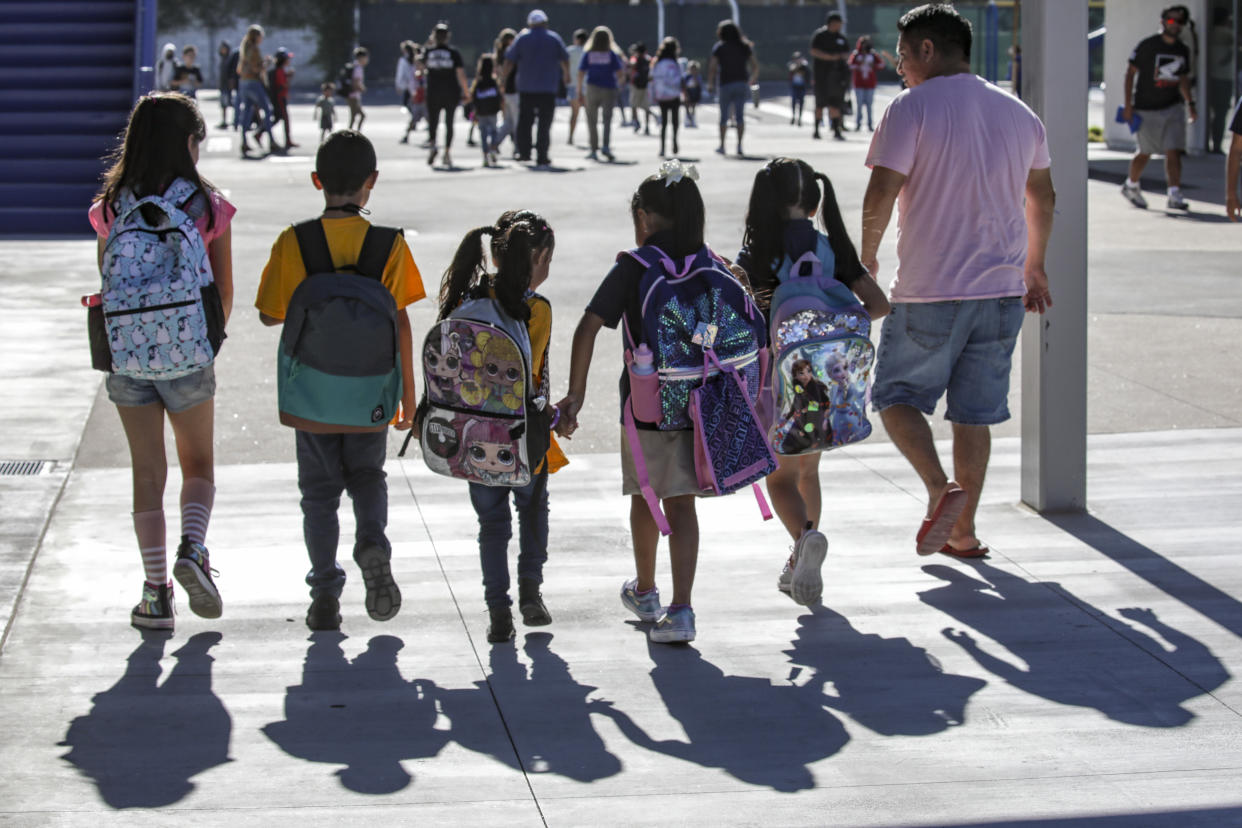Expert explains the CDC's new COVID guidance for schools
A new school year has begun for many kids across the U.S., and others are preparing to return to the classroom soon.
This is the third year that students and teachers head back to school while the country faces the COVID-19 pandemic. But this time around they can expect a degree of pre-pandemic normalcy. That is because the Centers for Disease Control and Prevention recently issued new COVID-19 guidelines for schools that loosen virus protocols and leave much of the decision making to families, schools and local officials.
The new federal guidance, the agency said, “acknowledges that the pandemic is not over,” but it allows Americans to decide what their own level of risk is and how they choose to mitigate that risk.
Yahoo News spoke to Dr. Michael Chang, pediatric infectious diseases specialist at UTHealth Houston and Children’s Memorial Hermann Hospital, on questions that people may have about the new CDC guidelines and how COVID-19 protocols have changed this school year.
Why did the CDC change COVID-19 guidelines for schools?
Chang told Yahoo News that the decision to change COVID-19 protocols in schools stems from the knowledge that scientists and health experts now have about how the virus affects children.
“Overall, you know, we can say that children seem less likely to have severe illness and hospitalization,” Chang said. He noted that some children do develop long COVID and need hospitalization but said the CDC recommendations “make sense.”
He added, “I think they're trying to give guidance for families to make their own kind of individualized and family decisions for what works best for them, in this context of having the lower risk of severe illness and hospitalization for most people.”
Dr. Greta Massetti, the CDC’s chief field epidemiologist, who announced the changes to the agency’s COVID-19 guidance on Aug. 11, said the decision took into account where we are in the pandemic right now.
“High levels of population immunity due to vaccination and previous infection, and the many tools that we have available to protect people from severe illness and death, have put us in a different place,” Massetti said, adding that based on the latest data, around 95% of the population now has some level of immunity due to to vaccination, previous infection or a combination of both.

No more routine screening testing, but there are some exceptions
This year parents can expect that their children will not need to be routinely tested for COVID-19 to stay in school.
The CDC is no longer recommending routine screenings unless the school is located in a community that Is experiencing high levels of COVID-19 spread. For schools in areas where community transmission levels are high, the CDC recommends that these institutions consider implementing screening tests for high-risk activities such as close-contact sports, band or theater, as well as before or after large events such as prom, tournaments and group travel, and when students and staff return to school from breaks such as holidays.
Quarantine is no longer recommended for asymptomatic people
One of the most significant changes in the updated CDC guidance is that the agency is no longer recommending home quarantines to students and school staff who are exposed to the virus but don't have symptoms.
Even if they come into contact with someone infected with COVID-19, students or staff who have no symptoms can continue to attend school as long as they wear a high-quality mask for 10 days and get tested after the fifth day. This recommendation applies for those who are both vaccinated and unvaccinated.
If someone does have symptoms and they test positive, Chang said they obviously should stay at home and isolate.
According to the most current CDC recommendation, anyone who tests positive and has symptoms should isolate at home for at least five days. If symptoms improve after the fifth day and the person has no fever for 24 hours without the use of medications to reduce that fever, the agency says the individual can exit isolation without the need to test again. That person should still wear a mask for 10 days after the onset of symptoms, according to the agency.
Chang, however, disagrees with the no-test-to-exit-isolation strategy. “As a pediatric infectious disease person, I would still recommend that if your child tests positive, or anyone in your family were to test positive, those people really should have negative tests before exiting isolation,” he said.
One reason Chang and other experts advise people to test before exiting isolation is that some studies have shown people can still be contagious after being sick with COVID-19 for five days.
Finally, based on the new CDC guidance, schools will also likely be ending a method called cohorting, designed to minimize COVID-19 exposure by keeping students in the same group throughout the day.
Does my child need to continue to wear a mask at school?
The CDC recommends universal indoor masking in schools located in areas where COVID-19 community transmission levels are high. According to the agency’s most current data, about 34% of counties in the U.S. have high levels of transmission.
Chang says that now more than ever, it is important for parents to follow local trends in virus outbreaks in order to decide on their own level of risk and whether their children should continue to wear a mask in school.
“Each family and parent will have to think about their individual family's risk,” Chang said. “Do they have high-risk individuals in their household? Is someone, say a grandparent with heart disease, living with them? In which case, they would want to be more cautious about continuing to wear masks, continuing to have some physical distance, and still limit high-risk indoor activities.”

